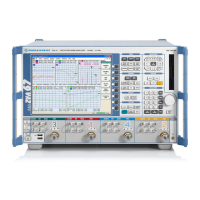Getting Started
R&S
®
ZVA
31Getting Started 1145.1090.62 ─ 13
formats allow you to express and display the results. depending on what you want to
learn from the data. Only one analyzer test port is required for reflection measure-
ments.
In the following example, the analyzer is set up for a reflection measurement, a fre-
quency sweep range and measurement parameter is selected, the instrument is cali-
brated and the result is evaluated using various formats.
2.1.1 Instrument Setup for Reflection Measurements
In order to prepare a reflection measurement, you have to connect your DUT (which for
simplicity we assume to have an appropriate connector, e.g. a male N 50 Ω connector)
to one of the (equivalent) analyzer test ports. Besides, it is recommended to preset the
instrument in order to set it to a definite, known state.
1. Proceed as described in chapter 1.4, "Starting the Analyzer and Shutting Down",
on page 22 to switch on the instrument and start the NWA application.
2. Connect the input port of your DUT to test port 1 of the network analyzer.
3. Press the PRESET key in the SYSTEM keypad to perform a factory preset of the
analyzer.
The analyzer is now set to its default state. The default measured quantity is the trans-
mission S-parameter S21. This quantity is zero in the current test setup, so the trace
shows the noise level.
Performing a Reflection Measurement

